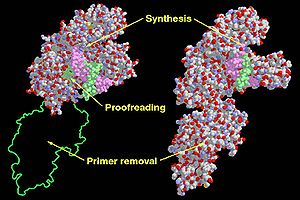
Klenow fragment
Encyclopedia

Protein
Proteins are biochemical compounds consisting of one or more polypeptides typically folded into a globular or fibrous form, facilitating a biological function. A polypeptide is a single linear polymer chain of amino acids bonded together by peptide bonds between the carboxyl and amino groups of...
fragment produced when DNA polymerase I
DNA polymerase I
DNA Polymerase I is an enzyme that participates in the process of DNA replication in prokaryotes. It is composed of 928 amino acids, and is an example of a processive enzyme - it can sequentially catalyze multiple polymerisations. Discovered by Arthur Kornberg in 1956, it was the first known...
from E. coli is enzymatically
Enzyme
Enzymes are proteins that catalyze chemical reactions. In enzymatic reactions, the molecules at the beginning of the process, called substrates, are converted into different molecules, called products. Almost all chemical reactions in a biological cell need enzymes in order to occur at rates...
cleaved by the protease
Protease
A protease is any enzyme that conducts proteolysis, that is, begins protein catabolism by hydrolysis of the peptide bonds that link amino acids together in the polypeptide chain forming the protein....
subtilisin
Subtilisin
Subtilisin is a non-specific protease initially obtained from Bacillus subtilis.Subtilisins belong to subtilases, a group of serine proteases that initiate the nucleophilic attack on the peptide bond through a serine residue at the active site. They are physically and chemically...
. First reported in 1970, it retains the 5'-3' polymerase
Polymerase
A polymerase is an enzyme whose central function is associated with polymers of nucleic acids such as RNA and DNA.The primary function of a polymerase is the polymerization of new DNA or RNA against an existing DNA or RNA template in the processes of replication and transcription...
activity and the 3’ → 5’ exonuclease
Exonuclease
Exonucleases are enzymes that work by cleaving nucleotides one at a time from the end of a polynucleotide chain. A hydrolyzing reaction that breaks phosphodiester bonds at either the 3’ or the 5’ end occurs. Its close relative is the endonuclease, which cleaves phosphodiester bonds in the middle ...
activity for removal of precoding nucleotides and proofreading, but loses its 5' → 3' exonuclease activity.
The other smaller fragment formed when DNA polymerase I from E. coli is cleaved by subtilisin retains the 5'-3' exonuclease activity but does not have the other two activities exhibited by the Klenow fragment (i.e. 5'-> 3' polymerase activity, and 3'->5' exonuclease activity).
Research
Because the 5' → 3' exonuclease activity of DNA polymerase I from E. coli makes it unsuitable for many applications, the Klenow fragment, which lacks this activity, can be very useful in research. The Klenow fragment is extremely useful for research-based tasks such as:- Synthesis of double-stranded DNA from single-stranded templates
- Filling in (meaning removal of overhangs to create blunt ends) recessed 3' ends of DNA fragments
- Digesting away protruding 3' overhangs
- Preparation of radioactive DNA probes
The Klenow fragment was also the original enzyme used for greatly amplifying segments of DNA in the polymerase chain reaction
Polymerase chain reaction
The polymerase chain reaction is a scientific technique in molecular biology to amplify a single or a few copies of a piece of DNA across several orders of magnitude, generating thousands to millions of copies of a particular DNA sequence....
(PCR) process, before being replaced by thermostable enzymes such as Taq polymerase
Taq polymerase
thumb|228px|right|Structure of Taq DNA polymerase bound to a DNA octamerTaq polymerase is a thermostable DNA polymerase named after the thermophilic bacterium Thermus aquaticus from which it was originally isolated by Thomas D. Brock in 1965...
.
The exo- Klenow fragment
Just as the 5' → 3' exonuclease activity of DNA polymerase I from E.coli can be undesirable, the 3' → 5' exonuclease activity of Klenow fragment can also be undesirable for certain applications. This problem can be overcome by introducing mutationMutation
In molecular biology and genetics, mutations are changes in a genomic sequence: the DNA sequence of a cell's genome or the DNA or RNA sequence of a virus. They can be defined as sudden and spontaneous changes in the cell. Mutations are caused by radiation, viruses, transposons and mutagenic...
s in the gene that encodes Klenow. This results in forms of the enzyme being expressed that retain 5' → 3' polymerase activity, but lack any exonuclease activity (5' → 3' or 3' → 5'). This form of the enzyme is called the exo- Klenow fragment.
The exo-Klenow fragment is used in some fluorescent labeling reactions for microarray.

